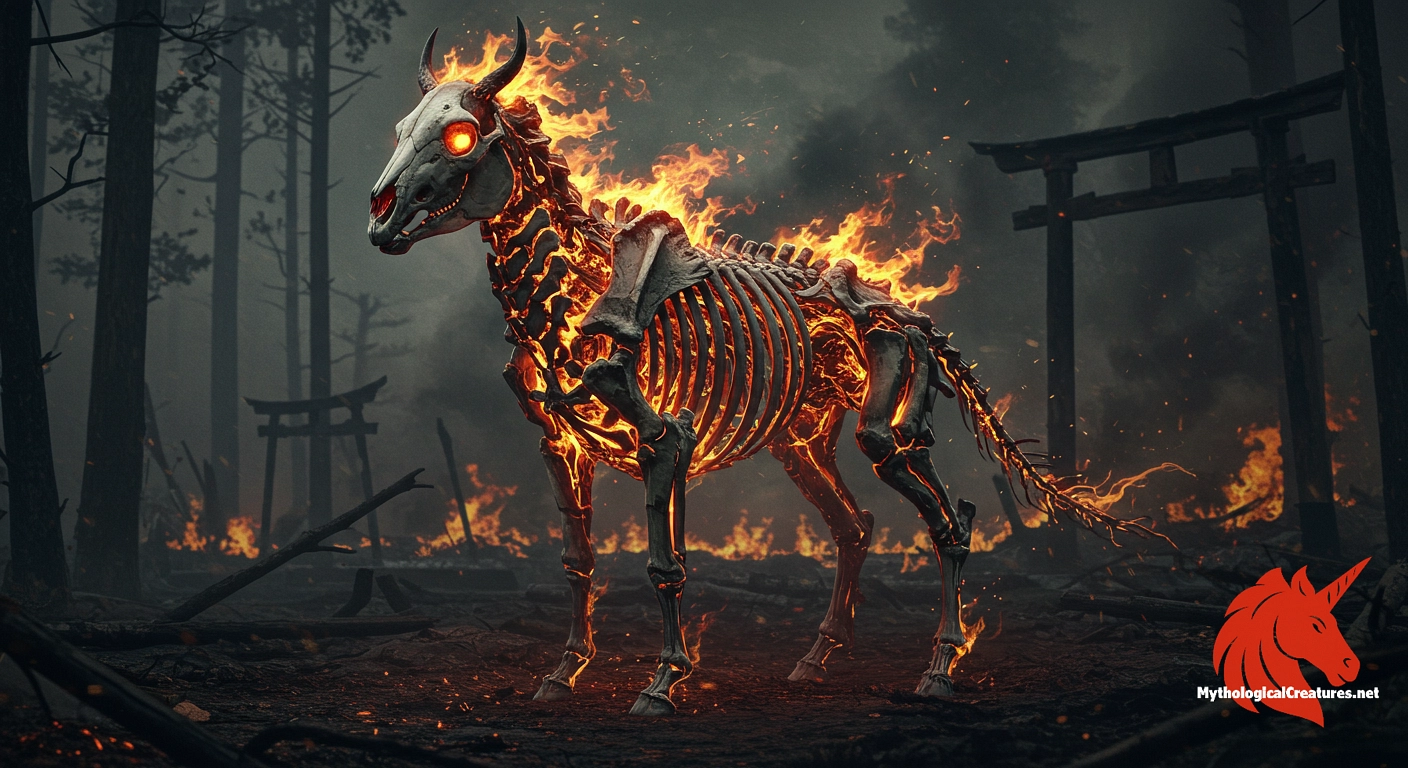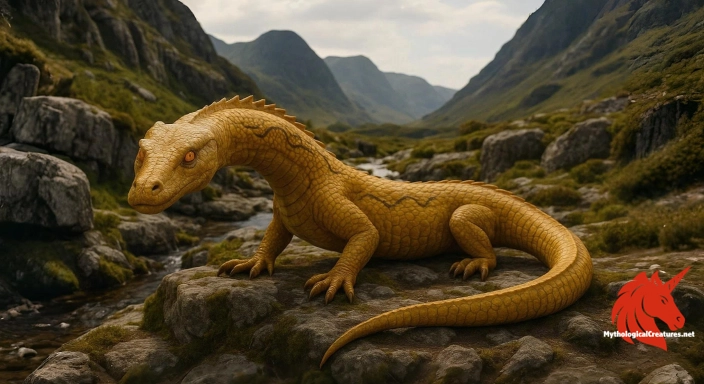Bakotsu: Bakotsu is a yōkai from Edo period Japanese folklore, depicted as a skeletal, flaming horse.

Bakotsu
Bakotsu - Bakotsu embodies themes of tragic demise and supernatural endurance, serving as a reminder of the spectral forces that emerge from loss and disaster.
Origins & First Encounters
Bakotsu is a striking figure in Japanese folklore, emerging as one of the unique yōkai during the Edo period that continues to intrigue cultural historians. Its spectral form, depicted as a flaming skeletal horse, captures the tragic essence of a spirit that once roamed the earthly realm. The creature is first attested in the Tosa Obake Zōshi, an influential compendium of supernatural entities from that era. Bearing a name that translates literally as 'horse bone', it symbolises the delicate remnants of life after a calamity. The lore surrounding Bakotsu is intertwined with the mystique of fire and transformation, invoking both fear and empathy. Tales suggest that this apparition represents not merely a lost animal but the lingering essence of a noble steed consumed by an unforgiving blaze. Its depiction has reverberated through centuries, reflecting both the capricious nature of fate and nature’s destructive powers. The narrative encapsulates a mix of sorrow, warning, and an enduring fascination with the unknown. Over time, the Bakotsu has become a powerful emblem of life’s fragility and the inescapable bonds between mortality and the supernatural.
Source Texts & Tale Variants
The primary account of Bakotsu is found in the Tosa Obake Zōshi, an Edo period manuscript that has long captured the imagination of yōkai enthusiasts. This document provides one of the earliest detailed depictions of a spectral, flaming horse, setting the stage for subsequent folklore. Its written record, though brief, has inspired a wealth of oral traditions that add layers to its mysterious character. Various retellings have elaborated on the original motif, often portraying the Bakotsu as a portent of misfortune or as a tragic spirit wandering the night. Some stories accentuate its role as an omen linked to disastrous fires, while others invoke a more sympathetic reading that mourns an untimely loss. Over the years, regional folklore and incidental mentions in other collections have helped to enrich its narrative. These additional variants sometimes introduce new elements, such as symbolic associations with rebirth or vengeance. The evolving story of Bakotsu reflects the dynamic interplay between written records and oral transmission over generations. Through these diverse sources, the legend of the Bakotsu remains a vivid and continuously reinterpreted part of Japanese myth.
Form & Powers
The Bakotsu presents a visually arresting and eerie silhouette that has fascinated both artists and storytellers alike. Its entire form is that of a skeletal horse, with each bone meticulously rendered to appear both fragile and enduring. The visage is dominated by a raging, unearthly flame that seems to emanate from within its skeletal structure, lending it an aura of supernatural energy. Fiery motifs embellish its mane and tail, which are depicted as streams of flickering light that dance and merge with the darkness of the night. The burning spectacle not only emphasises the tragic backstory but also accentuates the creature’s otherworldly nature. Its eyes, often portrayed as dark voids or smouldering coal-like spaces, convey an unsettling mix of sorrow and relentless fury. Although the core anatomy mirrors that of a majestic steed, the actual form is overlaid with an ethereal glow that transforms each bone into a beacon of spectral fire. Artists sometimes vary its proportions, with some illustrations representing it as an imposing giant while others focus on its more delicate, ephemeral qualities. The overall imagery is one of stark contrasts—the cold, bare bones set against the dynamic, consuming warmth of flames.
Regional Faces
Regional interpretations of the Bakotsu reveal a rich diversity in the way communities have embraced and adapted its legend. In the Tosa region, where the tale originated, it is often seen as a solemn reminder of the devastation wrought by uncontrollable fire and the loss that follows. Nearby areas have woven the Bakotsu into local rituals and superstitions, sometimes portraying it as a harbinger of calamity while at other times admiring its spectral nobility. Certain villages reinterpret the creature as a guardian spirit whose flaming form wards off further disaster, thus balancing awe with protective reverence. Local art and folklore have infused additional symbols, such as regional emblems or ancestral motifs, into the Bakotsu’s depiction. Some tellings stress the fiery rebirth aspect, aligning the creature with the cycles of nature and the cleansing power of flame. Variations in narrative tone—from cautionary tale to melancholic elegy—reflect the distinct cultural perspectives of different communities. Whether viewed as a remnant of a tragic past or a mystical force for renewal, the Bakotsu continues to be adapted to reflect local values. These regional adaptations ensure that, while its core imagery remains recognisable, each retelling bears the unique imprint of its cultural environment.
Cultural Parallels
Comparative analysis reveals that the Bakotsu shares thematic and visual parallels with various spectral steed figures found in global mythology. Much like the European headless horseman or the fearsome ghostly mounts of Celtic lore, Bakotsu embodies a haunting blend of beauty and terror. Its flaming, skeletal form resonates with the universal motif of the horse as a conduit between the earthly and the supernatural realms. In several cultures, fire is frequently associated with both destruction and purification, a duality that the Bakotsu so vividly personifies. Unlike some ghostly figures that serve solely as omens of death, the Bakotsu also tempers its dire warning with a sense of tragic beauty and reflective sorrow. Similar to other equine apparitions, it stands as a symbol of the transient nature of life and the inevitability of mortality. Cross-cultural echoes can be found in tales where spectral animals guide or forewarn humans, representing forces beyond mortal control. Such narratives serve as metaphors for the unpredictable power of nature and the thin line between life and afterlife. Through these similarities, the Bakotsu affirms its place within a broader, universal tapestry of myth where loss, retribution, and renewal are recurrent themes.
Legacy & Modern Evolution
The historical evolution of the Bakotsu mirrors the broader trajectory of myth, evolving from a purely ominous figure into a multifaceted symbol embraced by modern culture. Initially recorded as a grim reminder of fatal fires and the impermanence of life, its image has gradually been softened and reinterpreted by contemporary artists. Modern depictions often highlight the tragic beauty inherent in its flaming, skeletal form, thereby invoking reflections on both loss and eventual renewal. In recent decades, the Bakotsu has surfaced in various media, from graphic novels and films to digital art, each interpretation adding a new layer to its storied past. Its representation has shifted from a harbinger of doom to a more complex emblem of transformation and resilience. Contemporary narratives sometimes cast the creature as a guardian spirit, offering a commentary on historical trauma and the process of healing. Exhibitions and folklore festivals frequently revive its image, encouraging audiences to engage with traditional legends through a modern lens. The adaptation of its iconography underscores an enduring relevance in a world continually grappling with change and uncertainty. Ultimately, the Bakotsu’s evolution reflects how myth can transcend its origins to continually inspire reinterpretation and dialogue between past and present.
Interesting Fact
Despite its fearsome appearance, Bakotsu symbolises the eternal nature of the spirit and the complex interplay between destruction and rebirth in Japanese mythology.
Quick Creature Info
Associations:
Our Mythic Legendary Rating:

Also Sometimes Known As:
Habitat:
Supernatural Powers:
Physical Attributes:
Abilities:
Behavior:
Lore:
Related Creatures, Tales or Lore
References
Discover Another Mythical Legend You May Not Have Heard Of?
Uncover the mysteries of ancient folklore and expand your knowledge of legendary beings from cultures around the world.
Dare to Meet the Yellow Dragon....
Mythical Disclaimer: The images and data on this site are derived from various historical and literary sources, but we have found that many myths often have multiple versions and interpretations across references, sometimes contradictory. As a result, these creature depictions are artistic interpretations—imaginative blends of folklore, legend, and a dash of AI guesswork. Because creature descriptions vary widely, our illustrations and accompanying information represent our best effort to honor mythology while bridging creative gaps. Enjoy these interpretations—just remember, we've done our best to respect the stories and validate available data, but in the realm of mythology, details often shift, imagination leads the way, and nothing is ever set in stone!
Curated by the Mythological Creatures Team (rev. May 2025)
